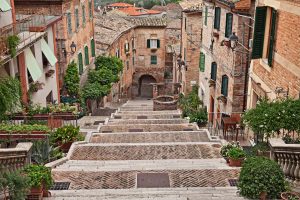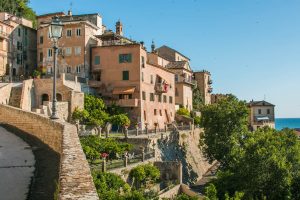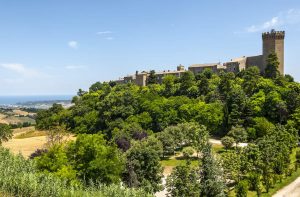
©Bigstock.com/ermess
Gently nestled between the Adriatic Sea and the Apennines, the Marche region is one of the most diverse regions in Italy. From the large Adriatic coastal towns in the east to the hilly countryside that begins just behind the coastline to the steep Apennine mountains on the border with Umbria and Abruzzo reaching altitudes of up to 2,476 metres, there is plenty of variety and natural beauty, not to mention the countless nature parks and protected areas. Nevertheless, the Marche region remains an insider tip and is full of magical little places that are sure to enchant you. The private Italian association “I borghi più belli d’Italia” compiles the most beautiful places in Italy – and there are plenty of them in the provinces of Ancona, Ascoli Piceno and Fermo.
Province of Ancona
Our first stop takes us to the Province of Ancona, which stretches from the coast to the mountains like a narrow strip. In addition to the somewhat sleepy capital, once colonised by the Greeks and conquered by the Romans, you will also find Loreto, the country’s second most important pilgrimage site after Rome. The Basilica of the Holy House is home to the house where Mary grew up and experienced the Annunciation. What’s more, five of the most beautiful places in Italy await you in the Province of Ancona.
Arcevia
Arcevia (approx. 4,300 inhabitants) is located in a strategically favourable position in the valley of the river Misa. This explains why the town was likely already inhabited in the Neolithic Age. Various archaeological excavation sites have uncovered finds dating back to the Bronze and Iron Ages, including a necropolis of Celtic Gauls. The impressive baroque church of San Medardo with its magnificent Renaissance works awaits you behind the mighty 13th century walls that gave Arcevia its name. It also houses the town’s archaeological museum.
Corinaldo
A ring of walls over 900 metres long which has surrounded Corinaldo (approx. 4,700 inhabitants) since the 15th century invites you on a spectacular tour full of mighty towers, battlements and ramparts. The heart of the town, however, is the Piaggia, a staircase of 100 steps surrounded by red brick houses. It leads you to the Pozzo della Polenta, a fountain surrounded by wild stories about a sack of flour that has been inspiring a town festival since the 1980s. The mighty church of Santa Maria del Suffragio with its terracotta façade wears its Roman inspiration with pride.
Morro d’Alba
The town walls in Morro d’Alba (approx. 1,800 inhabitants) are also a sight in themselves. At least part of them are, to be precise, the so-called Camminamento di Ronda or “La Scarpa”. This is a covered corridor about 300 metres long, which offers a view of the Sibillini mountains, Monte Conero and even the sea through its windows. You will also pass numerous tower entrances, some of which are open to the public, including the harvest museum Museo Utensilia.
Offagna
Like so many places in the province, Offagna (approx. 2,000 inhabitants) is best known for its Rocca, part of the large-scale supra-regional defences of the former Republic of Ancona that were intended to protect both the harbours and the hinterland. Built in the middle of the 15th century, it has largely retained its original appearance. A tour along the battlements, past high walls and even higher towers, takes you to a permanent exhibition on old weapons and a natural history museum dedicated to the Ancona-born scientist Luigi Paolucci. Just outside, the richly decorated Villa Montegallo overlooks the sea.
Sassoferrato
The ancient city of Sentinum once stood at the foothills of the Umbrian and Marche Apennines. Today you can marvel at its remains and finds in the archaeological museum of Sassoferrato (approx. 7,000 inhabitants). The imposing fortress of Albornoz was built directly on the ancient ruins in the 14th century and was intended to protect the town. The Middle Ages are brought to life in the Santa Croce monastery, which was built from building materials of the Sentinum ruins. This also applies to San Pietro, which was given a distinctly Renaissance flavour after collapsing. The Gothic church of San Francesco, on the other hand, impresses with countless paintings and frescoes.

©Bigstock.com/Buffy1982
Province of Ascoli Piceno
The fascinating travertine stone has left its mark on the eponymous city of arts, Ascoli Piceno, making the comparatively small capital a real eye-catcher. Also stretching in a thin strip from east to west, you can expect plenty of variety and many a sleepy village in the heart of the country. The three most beautiful places in the Province of Ascoli Piceno make this variety tangible.
Grottammare
Narrow alleyways lead through Grottammare (approx. 14,000 inhabitants), which has been inhabited since the Stone Age, is situated on the coast and is dominated by a huge 11th century castle – once an attractive hotspot for all kinds of celebrities, including composer Franz Liszt. Highlights include the extensively renovated Torrione della Battaglia, a 16th century defence complex that houses around 250 works of art and sculptures, as well as the churches of San Giovanni Battista and Santa Lucia, which are closely associated with Pope Sixtus V. As a modern splash of colour, the Art Nouveau villas on the harbour take you back to the late 19th century.
Montefiore dell’Aso
According to legend, Montefiore dell’Aso (approx. 2,300 inhabitants) got its name from Flora, the Roman goddess of (wheat) blossom. The numerous Roman and Stone Age artefacts found in the region attest to this. Hidden behind thick city walls with six defence towers is a charming town known above all for its many 18th century palaces. An absolute must-see, however, is the church of San Francesco, built between 1247 and 1303, whose façade still shines in its original splendour. Behind the Romanesque-Gothic walls, however, a radically renovated Baroque-style structure awaits you. The adjoining monastery has since been converted into a museum for art, film and ethnology.
Offida
The roots of Offida (approx. 5,200 inhabitants) are said to date back to the Stone Age, according to finds. From the 9th century onwards, the town flourished due to the agricultural activities of the Benedictine monks from Farfa. The town walls and town hall were gradually built before the Papal States seized power after centuries of conflict. Eight churches are reminders of this period, including the magnificent Santa Maria Rocca, surrounded on three sides by ravines. The imposing Romanesque-Gothic building with its clearly defined yet playful façade and frescoes in the style of Giotto will also cast a spell over you.
Province of Fermo
The Province of Fermo was part of Ascoli Piceno until 2004 and eventually became independent – as an even narrower strip of land that only borders the mountains. Impressive architecture ranging from Roman ingenuity to imposing theatres adorns the capital, and several magnificent harbour towns await you as well. And then there are the three most beautiful places in the Province of Fermo which are sure to delight.

©Bigstock.com/Claudiogiovanni
Moresco
A seven-sided tower stand tall in the centre of Moresco (approx. 600 inhabitants). It is not clear why this 25-metre-high 12th century giant has this particular shape, but from the top you have a great panoramic view from the Gran Sasso mountains to the coast of Albania. The bell tower is another tell boy, its 16th century bell still chiming. Moresco was given numerous churches during the 16th century, a time of great wealth, including San Lorenzo with a large number of 17th and 18th century paintings and Madonna dell’Olmo with a large fresco by Vincenzo Paganini. The former church of Santa Sofia has been converted into a small theatre.
Petritoli
Petritoli (approx. 2,100 inhabitants) was founded around the year 1000 by the monks of the Farfa monastery on one of the region’s seven hills at a junction of the Roman road Via Salaria. To get started, we recommend a short tour of Borgo Vecchio with its main street, s adorned with terracotta portals and medieval inscriptions. One of the most important sights is Tre Archi, a gate from the early 15th century that was rebuilt over 400 years later in neo-Gothic style and now fulfils a purely decorative purpose. The Torre Civico consists of five different geometric shapes, carefully built on top of each other.
Servigliano
Originally named Castel San Marco after the fortress that dominated the town, it was abandoned due to geological instability and rebuilt elsewhere. Today’s Servigliano (approx. 2,300 inhabitants) was almost entirely constructed in the neoclassical style. Three monumental gates lead into the borgo that was laid out like a Christian cross – almost unique in the whole of Europe. The relics of Saints Servigliano and Gualtiero are housed in the collegiate church of San Marco. The town became sadly famous for a prisoner of war camp active during the First and Second World Wars that was transformed into the important memorial Parco della Pace (“Peace Park”) after the wars.
The most beautiful places in the provinces of Ancona, Ascoli Piceno and Fermo could hardly be more different. Some are dominated by old fortifications and long walls, while others are characterised by natural beauty, and elsewhere the scenery is ruled by imposing churches. The Marche region really does have something for everyone and invites you to enjoy a different and certainly inspiring holiday in Italy.